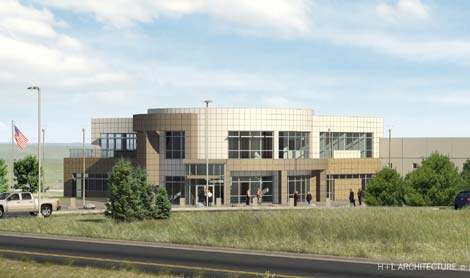
A drawing of the future NCAR-Wyoming Supercomputing Center being built in Cheyenne, Wyoming.
The National Center for Atmospheric Research (NCAR) broke ground yesterday on a new data center in Cheyenne, Wyoming that will house one of the world's most powerful supercomputers. The future NCAR-Wyoming Supercomputing Center (NWSC) will be a 171,000 square foot facility in North Range Business Park.
Scientists will use the supercomputing center to accelerate research into climate change, examining how it might affect agriculture, water resources, energy use, sea levels and impact on extreme weather events, including hurricanes.
The $70 million facility will include 24,000 square feet of raised floor data center space, with the current design plan calling for a 10-foot raised floor and 9-foot ceiling plenum to manage airflow required to cool the IT gear. The new machine is expected to rank among the world’s 25 fastest supercomputers. The speed, and manufacturer of the supercomputer will be determined through the initial procurement process, which has an estimated budget of $25 million to $35 million.
Includes Archive for Climate Data
The center is a partnership among NCAR, the National Science Foundation (NSF), the University of Wyoming (UW), the state of Wyoming, Cheyenne LEADS, the Wyoming Business Council, and Cheyenne Light, Fuel and Power. It will also house a data storage and archival facility that will hold, among other scientific data, unique historical climate records.
"After extensive planning and preparation, it’s gratifying to see the pieces coming together for construction," said University of Wyoming President Tom Buchanan. "I look forward to the supercomputing center coming online because it’s so important to the research we’re doing."
Buchanan says that the university’s primary use for the supercomputing facility will be to model flow in porous media, in order to better understand how water and carbon dioxide move through the spaces that exist in rocks. This research is critical to the university’s work in carbon sequestration - the development of methods to keep carbon dioxide from fossil fuels out of the atmosphere.
Need for More Powerful Supercomputer
NCAR, which is based in Boulder, has housed supercomputers in its Mesa Laboratory in southwest Boulder for decades, but needs a new purpose-built facility for the increasingly powerful machines. Most researchers will interact with the center remotely, via the Internet.
The NWSC is pursuing gold certification under the LEED ( Leadership in Energy and Environmental Design) program, a voluntary rating system for energy efficient buildings overseen by the US Green Building Council. The facility, which is designed specifically for scientific supercomputing, is scheduled to open its doors in 2012.
The supercomputer will likely consume about 3 to 4 megawatts of electricity. The NWSC will get 10 percent of its power from wind energy, with the option to increase that percentage.
Economic Development Significance
The project is a showcase for the state of Wyoming, which has been actively pursuing data center projects. The state's economic development team has attended major industry conferences for several years, highlighting Wyoming as a destination for data center development.
"We are delighted that construction on the supercomputing center in Cheyenne is moving forward," said Wyoming Governor Dave Freudenthal. "The partnership with NSF, UCAR, and NCAR allows Wyoming to develop its technology portfolio. The research capabilities it will allow UW will be of great benefit to the state."




